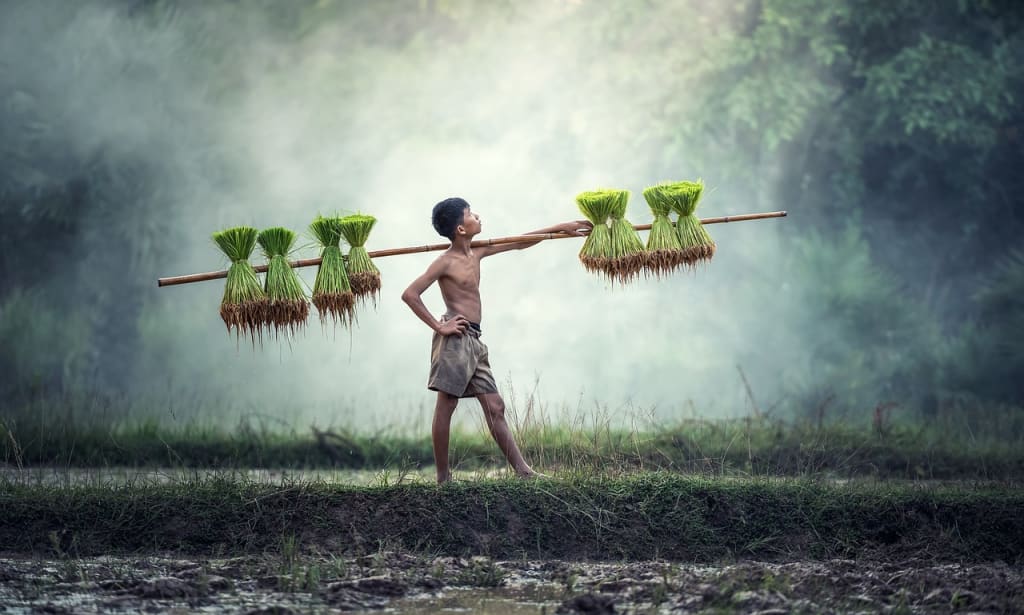The world's Most Important Food!!
Why is rice so popular? - Carolyn Beans

If the world's population were weighed against the total amount of rice consumed annually, the weight of the modest grain would be substantially in favor of rice. Because of its adaptability and widespread use, rice is a staple in many cuisines all over the world. Nigerian jollof and Korean bibimbap are only two examples of its global culinary influence. But how did this humble grain end up being a mainstay in so many different cultures? Come along on a journey spanning millennia and continents as we explore the fascinating history and environmental effects of rice production.
**The Story of Domestication and the Origins of Rice:**
In Chapter One, we travel back to the earliest days of agriculture, when individual crop domestication occurred by early farmers in Asia, Africa, and South America. Asian rice has a history spanning over 10,000 years, with its origins thought to be in what is now China. Farmers have produced thousands of kinds over millennia of selective breeding, each suited to different growing circumstances and preferences. In the meantime, analogous initiatives in South America and Africa resulted in the domestication of their own distinctive strains of rice, albeit with a smaller distribution.
In ancient China, rice farming was not only a way to feed people but also a significant part of their cultural and spiritual traditions. Since rice was associated with fertility and abundance in Chinese culture, it was frequently used in religious rites and celebrations. As rice farming expanded throughout Asia, it became a mainstay of the cuisine as well as the foundation of society and the economy.
**Culture and Ritual of Rice: Annaprashan to Gohan:**
As we go on to Chapter Two, we examine the cultural importance of rice in many global communities. A child's first taste of rice is commemorated in India during the Annaprashan event as a symbolic move to solid foods. Because "gohan" in Japanese means both "cooked rice" and "meal," it emphasizes how important rice is to everyday survival and cultural identity. Rice permeates customs and rituals from conception to death, influencing communities' collective consciousness all throughout the world.
Not only is rice a food source, but it also serves as a cultural symbol that unites people. Rice is more than just a food in many Asian cultures; it also represents wealth, fertility, and ancestry. The production and eating of rice are integral parts of everyday life, as seen in the complex rice terraces of Southeast Asia and the meticulously made rice cakes of Japan.
**The Yields and Emissions of Rice Cultivation: A Balanced Approach:**
The environmental impact of rice farming is discussed in Chapter 3, with special attention to its large contribution to greenhouse gas emissions. Although flooded paddy fields produce large yields, they also act as havens for methanogens—microorganisms that produce methane. This powerful greenhouse gas, methane, is a serious danger to the stability of the climate. But creative approaches to managing water, such switching between soaking and drying, present viable ways to lower methane emissions without sacrificing output, which is an essential first step toward sustainable rice farming.
Beyond greenhouse gas emissions, the environmental effects of rice farming also include water use, land degradation, and biodiversity loss. Native American populations have been uprooted and vital ecosystems have been lost as a result of the conversion of natural habitats into rice fields. Additionally, worries about soil erosion and water pollution have been raised by the extensive use of fertilizers and pesticides in rice farming.
**Difficulties and Possibilities: Making Your Way to Sustainability:**
We address the potential and difficulties that come with making the switch to more environmentally friendly rice producing methods in Chapter 4. Even while flooded paddy farming is deeply ingrained, growers and academics are developing innovative ways to lessen the impact on the environment without sacrificing yields. In an era of climate unpredictability, rice agriculture needs to be protected through a multifaceted strategy that incorporates both traditional wisdom and technology breakthroughs.
While there are many obstacles in the way of sustainable rice farming, there are also many chances for creativity and teamwork. Through the integration of science, technology, and traditional wisdom, comprehensive solutions that support social justice, environmental sustainability, and economic resilience can be created. Agroforestry systems and precision agricultural approaches are only two of the many ways that rice can be grown both sustainably and to feed the world's expanding population.
**Result: Moving Forward with Rice in a Sustainable Way:**
We leave our investigation having gained a deeper understanding of the common grain that feeds billions of people worldwide. Because of its extensive cultural history and environmental significance, rice represents a microcosm of the intricate interactions that exist between human society and the natural world. Let's learn from the past as we handle the challenges of the twenty-first century and seize the chances for creativity and teamwork that lie ahead. We can support future generations' health of the earth as well as our own by fostering a sustainable future for rice.
Thank you for reading.
If you like it, please share, comment, subscribe for more, or do all three.
Leave me a tip which I put toward book purchases, literary magazine subscriptions, and submissions fees.
About the Creator
Abdur Rahman
Hey there! I'm passionate about writing in science, horror, and fantasy genres. I'm all about supporting fellow writers,
so feel free to leave a tip! It helps fund my book purchases and submission fees for literary magazines.






Comments
There are no comments for this story
Be the first to respond and start the conversation.